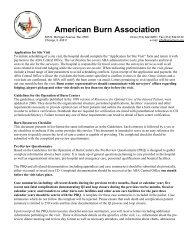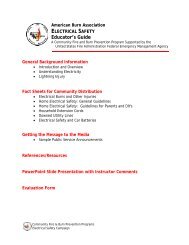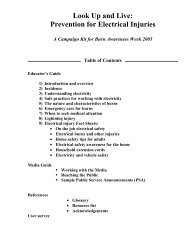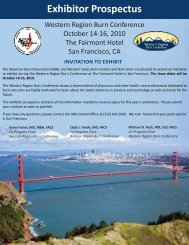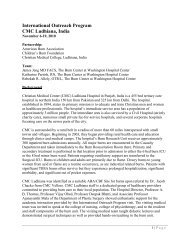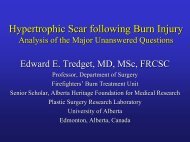44th Annual Meeting April 24 - American Burn Association
44th Annual Meeting April 24 - American Burn Association
44th Annual Meeting April 24 - American Burn Association
Create successful ePaper yourself
Turn your PDF publications into a flip-book with our unique Google optimized e-Paper software.
GENERAL MEETING INFORMATION<br />
Plenary Sessions<br />
Plenary Sessions provide information on topics of broad importance<br />
and applicability to all attendees. It’s a time when all participants<br />
come together to hear a topic of interest, led by a<br />
panel of experts. This year’s plenary sessions are listed below.<br />
Opening Ceremony, Presidential Address, and Awards<br />
Presentation †<br />
Wednesday, <strong>April</strong> 25<br />
8:00 am - 9:30 am<br />
“Our Third Leg: We Have<br />
Seen It All Before”<br />
Nicole S. Gibran, MD, FACS<br />
Director, University of<br />
Washington Regional <strong>Burn</strong><br />
Center<br />
Professor, UW Department of<br />
Surgery<br />
Harborview Medical Center<br />
Seattle, WA<br />
As a result of attending this activity, the learner should be able<br />
to: (1) Evaluate clinical and scientific conceptions that are the<br />
basis for burn heritage; and (2) Demonstrate that our scientific<br />
discoveries depend on elementary clinical observations at the<br />
bedside and on common sense; (3) Illustrate that our future<br />
success depends on synergism and our joint efforts will be<br />
greater than the sum of individual contributions.<br />
Presidential Plenary †<br />
Thursday, <strong>April</strong> 26<br />
8:00 am - 9:30 am<br />
“International Global Health”<br />
Moderator: Nicole S. Gibran, MD, FACS<br />
The burn community needs to understand the benefits of reaching<br />
out to the International Community to improve the state of<br />
burn care in underserved countries.<br />
As a result of attending this activity, the learner should be able<br />
to: (1) Understand the roles of burns as part of the global burden<br />
of disease; (2) Examine the benefits of reaching out to the<br />
International Community to improve the design of burn care in<br />
underserved countries; and (3) Analyze the significance of burn<br />
injuries as a cause of disability in a developing country.<br />
Plenaries †<br />
New this year, there are two plenaries offered on Friday<br />
morning, “Disaster Management” and “Return to Work.”<br />
Friday, <strong>April</strong> 27<br />
8:00 am - 9:30 am<br />
“Disaster Management”<br />
Speakers: Nicole S. Gibran MD, FACS, & James C. Jeng MD,<br />
FACS<br />
There remains a significant gap between the current ability of<br />
the burn care community and government to respond to a mass<br />
casualty event and produce a positive outcome.<br />
As a result of attending this activity, the learner should be able<br />
to: (1) Examine the importance of workable plan to care for 200,<br />
2,000 or 20,000 burn injuries in the event of a mass casualty;<br />
and (2) Understand and interpret an effective hospital, local,<br />
state, or nationwide response to mass casualties.<br />
“Return to Work after a <strong>Burn</strong> Injury”<br />
Speakers: Peter C. Esselman, MD, & Kurt L. Johnson, PhD<br />
Return to work is an important goal of any burn rehabilitation<br />
program. There is increasing knowledge regarding barriers to<br />
return to work after burn injuries and increased recognition of<br />
this issue in the burn community.<br />
As a result of attending this activity, the learner should be able<br />
to: (1) Understand the barriers to return to work after burn<br />
injury, promote and support return to work activities in their<br />
patients; and (2) Understand the role of vocational rehabilitation<br />
and what services are available to assist with return to<br />
work after a burn injury.<br />
Correlative Sessions<br />
The Correlative Sessions present current research results in sessions<br />
moderated by experts in the field, with a question and<br />
answer period after each presentation. The sessions showcase<br />
new information on basic science and clinical management<br />
issues in the format of short presentations by investigators of<br />
accepted abstracts.<br />
Abstracts are loosely grouped into topic areas, but “room hopping”<br />
during the concurrent sessions is encouraged. All presented<br />
abstracts will appear in the ABA <strong>Annual</strong> Program Book,<br />
published as a supplement to the Journal of <strong>Burn</strong> Care & Research.<br />
ABA members receive the Program Book before the <strong>Meeting</strong>;<br />
others pick up their copy on-site.<br />
More Reasons to Attend<br />
With more than 75 sessions and 2,000 attendees, the ABA<br />
<strong>Annual</strong> <strong>Meeting</strong> is the best opportunity to enhance knowledge<br />
about the latest scientific and practice advances in burn care.<br />
Virtually every aspect of the field is explored in this educational<br />
meeting—prevention, research, rehabilitation, treatment,<br />
administration and more—in a variety of educational formats.<br />
Via educational formats like plenary sessions, symposia, and<br />
panel discussions, information exchange is facilitated among all<br />
team members in burn care.<br />
4




